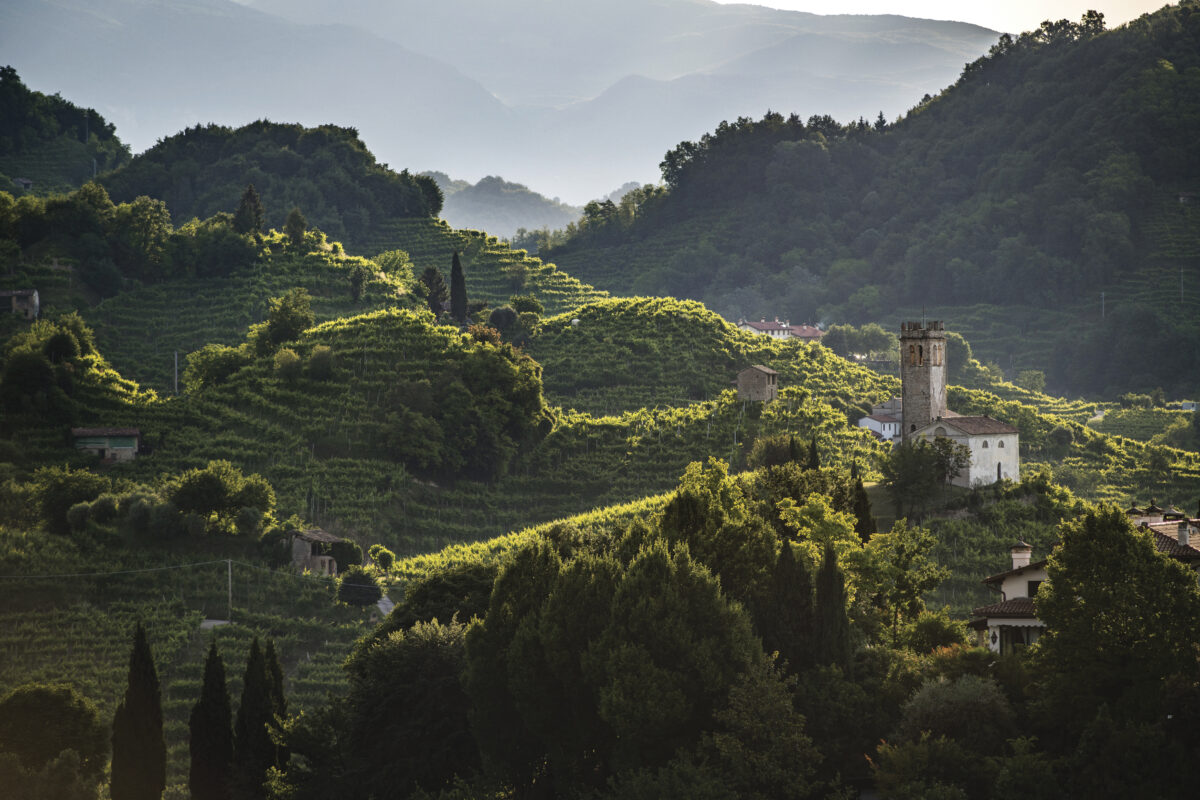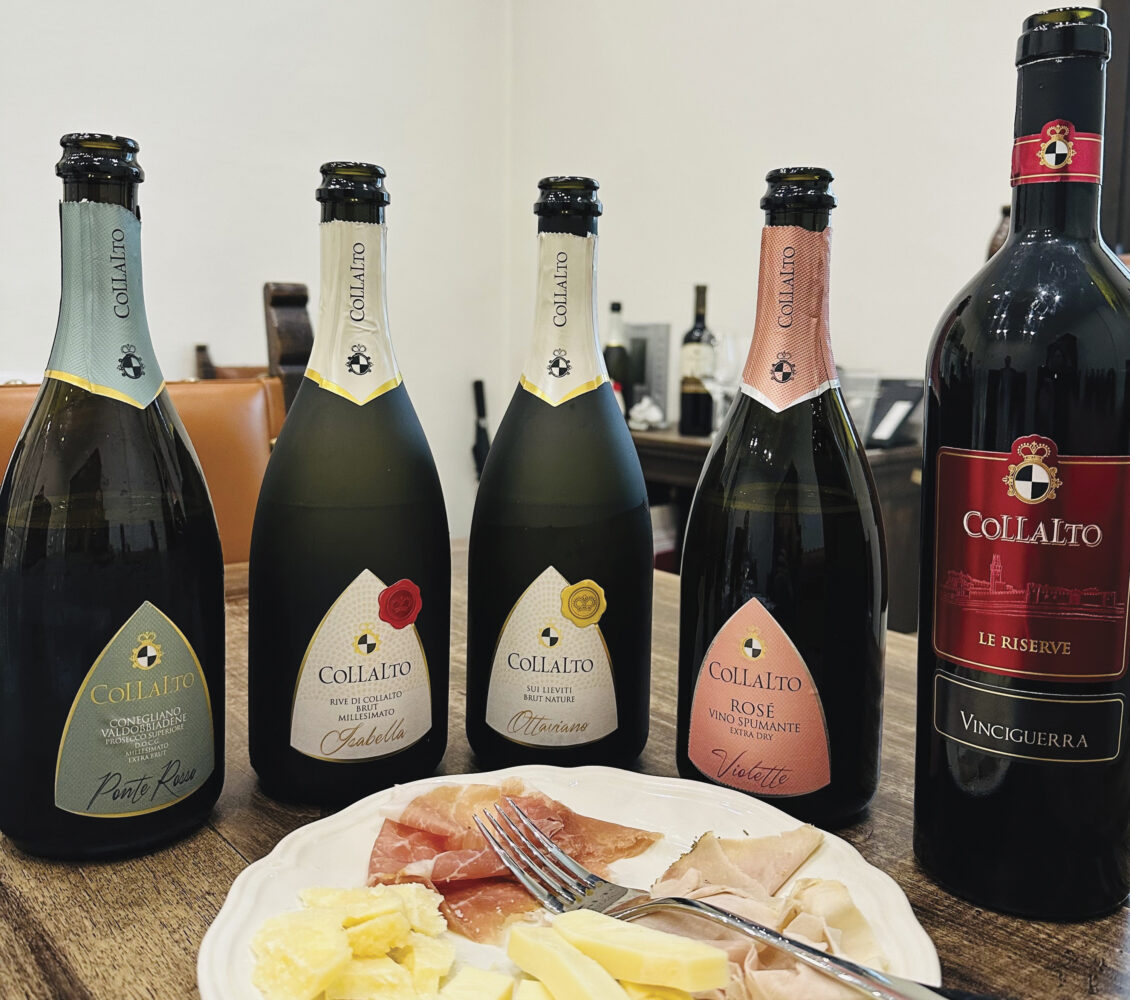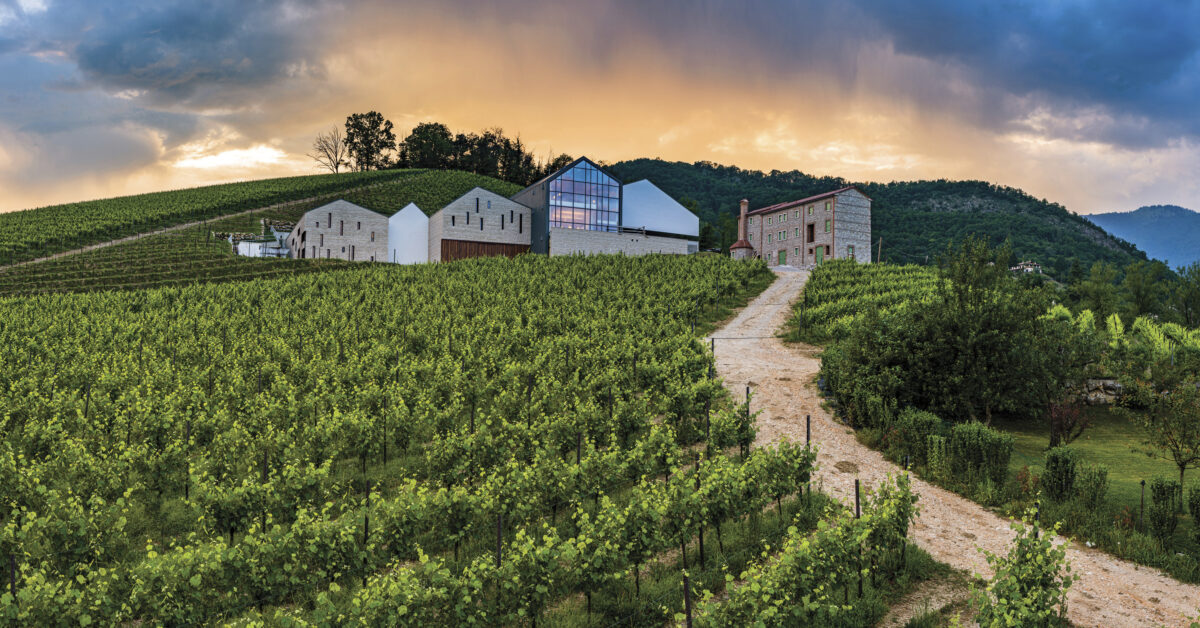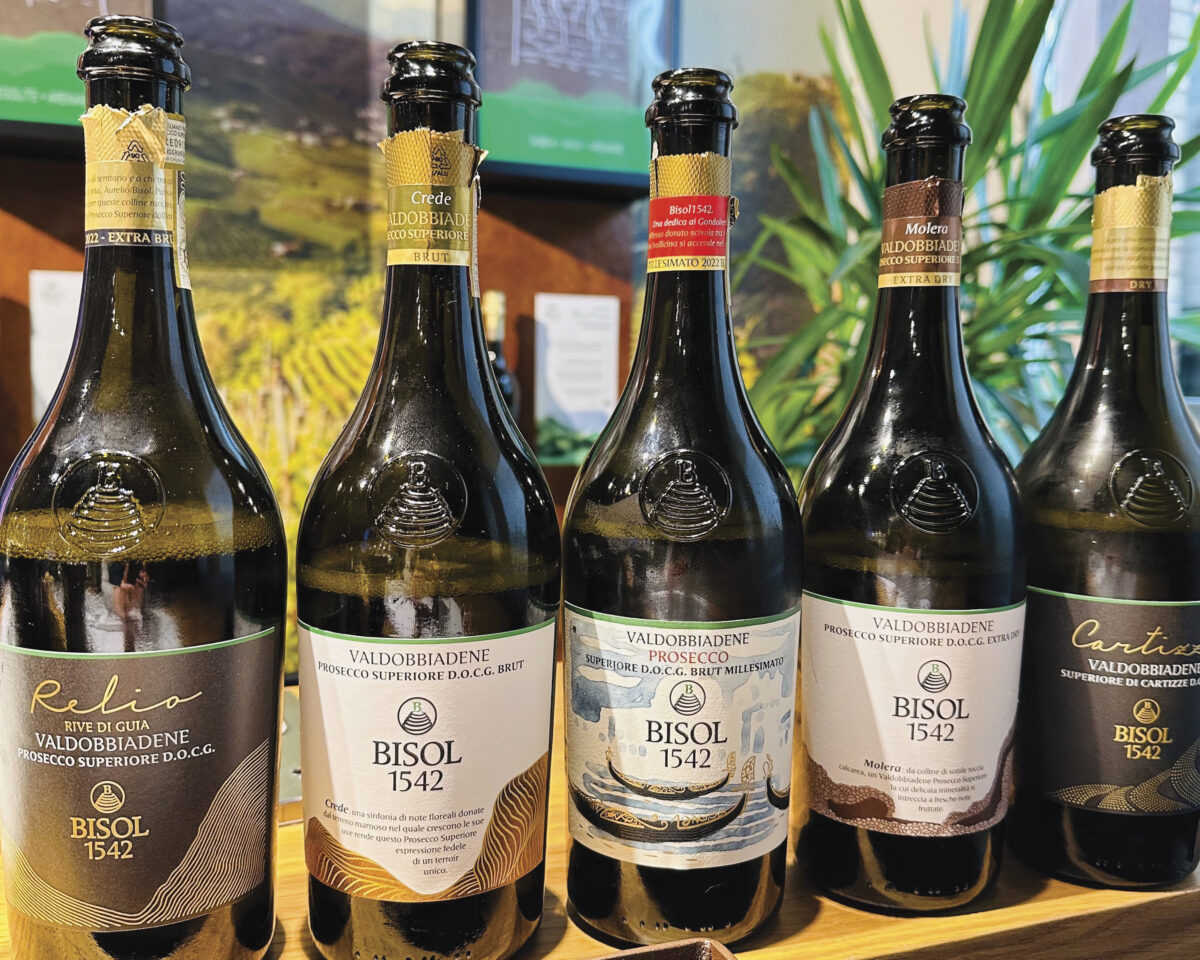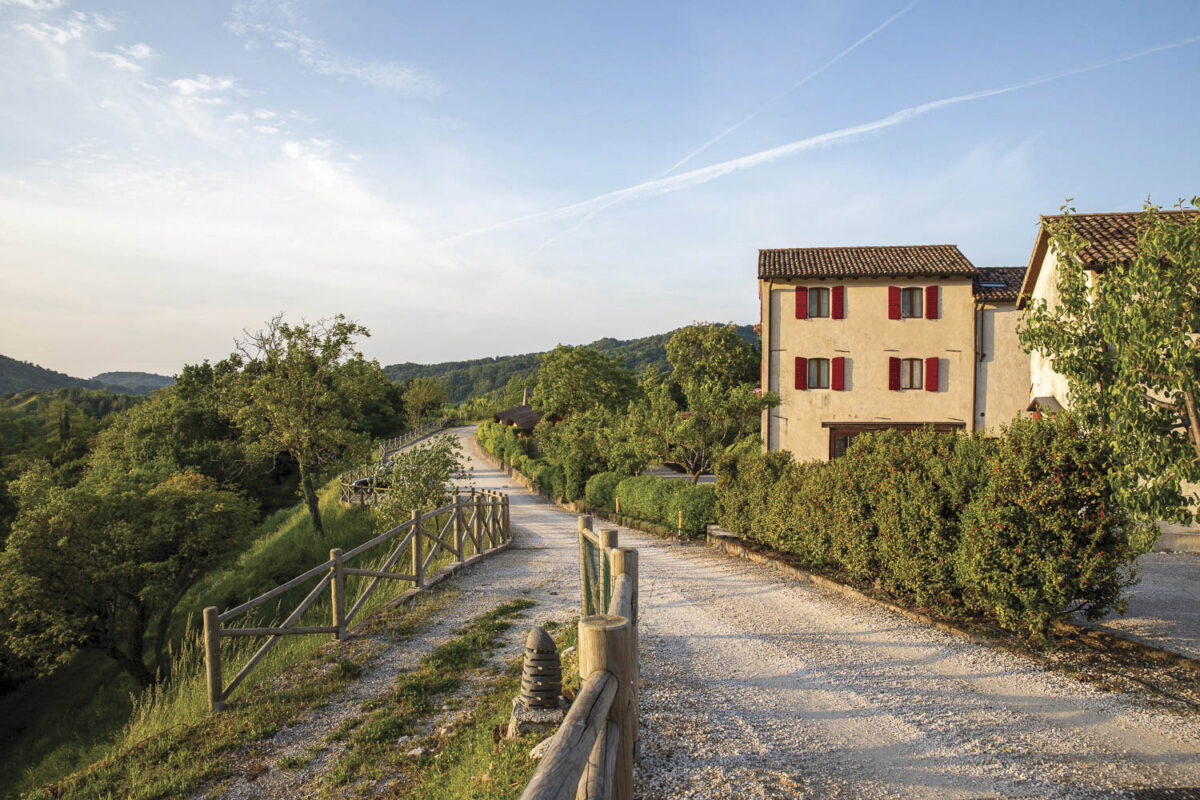Like a Van Gogh painting come to life, Conegliano Valbobbiadene’s undulating mosaic of hillside vineyards can’t help but captivate. Located north of Venice, just below the Alpine-Dolomite areas of Veneto, the 2019 designated UNESCO Heritage site is the heartland of Italy’s top-quality Prosecco production. Featuring breathtaking vistas of wooded hillsides, charming hamlets, and vines as far as the eye can see, the setting, selected by The Cité des Civilisations du Vin in Bordeaux as one of the world’s 22 most outstanding wine landscapes, is uniquely mesmerizing.
Conegliano Valdobbiadene is the dynamic nucleus of a larger area that represents the entire world of Italy’s iconic Prosecco wine, known generally as a fun, fruity and floral bubbly and the additive to cocktails such as the Bellini and the Aperol Spritz. But the Prosecco Superiore produced in this Denominazione di Origine Controllata e Garantita stands on its own.
The Pyramid
The region’s varied panorama of natural environments includes several Denominations: Conegliano Valdobbiadene Prosecco Superiore DOCG, Asolo Prosecco Superiore DOCG, and Prosecco DOC. The three correspond to areas that differ in size and landscape, the production complexity of which is represented in a theoretical pyramid. The base is Prosecco DOC, produced in a vast area that includes nine provinces in the Veneto and Friuli Venezia Giulia regions. In the central part of the pyramid is Asolo Prosecco Superiore DOCG, and Conegliano Valdobbiadene Prosecco Superiore DOCG is at the top. The region’s output represents the top-quality expression of Prosecco; the finest interpretations are known as “Rive.” And at the pyramid’s summit is Superiore di Cartizze DOCG, the “Grand Cru” of Conegliano Valdobbiadene. So superlative is this small region that just one vineyard hectare is valued at more than $2M euros, making it Italy’s second highest valued wine land.
The Terrain
The official description for Conegliano Valdobbiadene’s patchwork series of steep, rugged, east-to-west, valley-interspersed slopes is “hogback.” Over the centuries, the area’s inhabitants have adapted to the challenging environment, shaping its inclines while perfecting agricultural technique, illustrated by the ciglioni, a type of terrace covered not with stones but with grassy soil that helps reinforce the slopes and reduces soil erosion. The result is a quilt-like, layer-upon-layer topography that is at once chaotic yet ordered. More than 200 producers and 3000+ growers call the region home. All are focused on small production, high-elevation winemaking where the region’s extreme terrain dictates that all harvesting occur painstakingly by hand.
Prosecco vs champagne
The Prosecco made here is a beautiful, high-quality product with a general retail price that belies the artisanal aspects. Consumers often compare Prosecco (which contains at least 85% of the Glera grape; traditional varieties used for the additional 15% include Verdiso, Bianchetta Trevigiana, Perera, and Glera Lunga) to more costly champagne, reasoning that Prosecco’s lower price must naturally equate to lower quality, a misconception that unfairly maligns what can be an equally elegant wine. The fallacy is partly due to champagne’s savvy marketing, and the making of Prosecco is a bit less labor intensive (outside of the strenuous harvest.) Prosecco is made using the “Martinotti Method” (or tank method), where the second fermentation takes place in tanks, as opposed to champagne’s “Methode Traditionnelle,” which requires more production hours and is bottle fermented. Yet Conegliano Valdobbiadene’s Proseccos Superior DOCG are every bit as sophisticated, sublime, and sparklingly satisfying as fine champagne, with an added bonus of a lower overall ABV; most average 11%, making them eminently drinkable nearly any time of day, and that is how Italians feel Prosecco is meant to be enjoyed.
Wineries to Visit
Though less than an hour’s drive or train ride from Venice, the region is relatively crowd free. Spanning 18 square miles of Europe’s first official wine route, the Prosecco Road, and 15 small communes (towns), each more charming than the next, the area features a rich history, authenticity, and warm hospitality at wineries such as Collalto, where the family’s centuries-old Castello San Salvatore sits high on a hill, surrounded by the most extensive wine-growing estate in Conegliano Valdobbiadene. Tour the historic cellars and the castle, and discover the history that has linked the Collalto family to wine production in this region for over a thousand years. // www.cantine-collalto.it
At Prapian, old and new converge at this family-owned estate, where Prosecco is crafted within state-of-the-art facilities using certified organic grapes. Octogenarian founder Filiberto Sacchetto works alongside his son Paolo and daughter Beatrice to create elegant wines that can be sampled at a massive solid elm table overlooking the surrounding countryside. // www.prapianvini.it
The charismatic Gianluca Bisol oversees his family’s Bisol 1542 winery, which boasts five centuries of history and 21 generations of winemaking. Tour the historic cellar, and taste your way through the various crus, each of which has a story, such as the popular Jeio label, named for Gianluca’s grandfather Desiderio “Jeio” Bisol, whose vision and constant search for the best vineyard land plots have led to a product of great distinction and sublime taste. // www.bisol.it
Where to Dine
The region’s cuisine matches the elegance of the wines. Consider lunch at Salis, where two terraces allow for al fresco dining while overlooking the prized Cartizze hilltop. Owner and chef Chiara Barisan crafts original “beyond pasta and pizza” dishes that are as beautiful as they are delicious, such as tortelli stuffed with blue crab and Jerusalem artichoke cream. www.salisristorante.it
For dinner, Il Capitello offers a warm and welcoming environment where tradition meets innovation. Seasonal menus feature unique dishes made with the highest quality local ingredients. The Possamai family, in the restaurant business since 1968, operates this lovely spot with a gracious hospitality that is illustrative of that within the entire region. // www.ilcapitello.com
Stay Overnight
With so much to explore, a multi-night stay is essential. The charming and centrally located Duca di Dolle Relais (also a Prosecco Superiore producer) provides an ideal home base. Historic architectural elements and furnishings combine with modern amenities for an authentic Italian countryside stay. The vineyard adjacent swimming pool and pool deck with chaise lounges provide the perfect spot to relax after a day of Prosecco Superiore tasting. // www.ducadidolle.it


